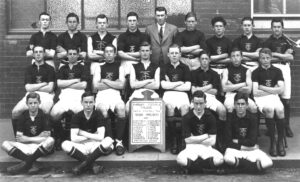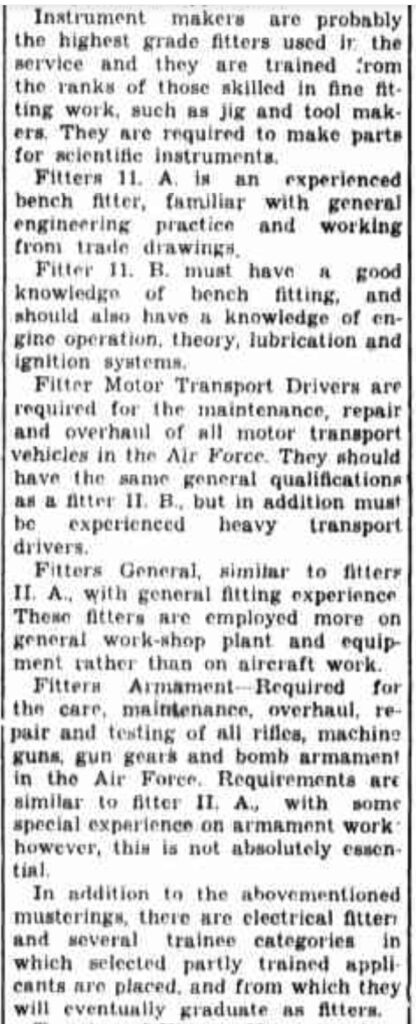Cipher Mysteries readers may recall that I recently suggested that, to find out more on the suggested connection between Carl Webb and the “C Webb” at Swinburne Technical College in the early 1920s, it would be good to ask the archivists at Swinburne (now Winburne University). Well, I did: but sadly the only things they were aware of were the same football team photographs we had all been debating here. They too tried cross-referencing between different photographs, but (like us) only managed to work out a couple of names.
I also suggested that more information might be found in the Examination Results books for Swinburne Technical College, though these were held not by Swinburne but by the Public Records Office of Victoria. So you can probably imagine my delight when Melbourne-based CM commenter Jo took time out from the demands of doing a PhD to look at these very same results books!
Charles Webb’s Examination Results
What Jo found were not only the two “beautifully bound” Examination Results books for the 1909-1929 Engineering Department I had hoped for, but also the 1916-1922 Departmental and Annual Supps book, “a rather more used looking book, comprising type written pages glued onto the pages of more officious looking ledger”, and where results were often signed off “Yours obediently”.
Hence we can merge these two sources together to get a timeline for what Webb was studying there:
1920:
- Practical Plane Geometry [Pass]:
- Arithmetic (Practical Mathematics) (73)
- Algebra (Practical Mathematics) (90) joint 2nd with Lisle Clegg behind Douglas Dumsday:
1921:
- Practical Solid Geometry – Fail! (Footballer A. Dubberlin failed the same class)
- Junior Technical Certificate – Pass with Credit [“C Webb”]
- Education Department Technical Schools Annual Examinations in Practical Mathematics [Pass]:
- Elementary Modelling. (No photo)
1922:
- Engineering Drawing Grade I [75] Credit:
- Electricity and Magnetism I [62]:
Absent from the archives
Even though historical archives are – almost necessarily – incomplete, there are some obvious gaps. For a start, the list of Scholarships awarded to Evening Students in 1921 by the College Council included only Leonard Bennett and Stanley Preece (i.e. no sign of Webb), which is perhaps a little odd.
But more importantly, there seems to be no sign of Webb there after 1922, even though (for example) fellow footballer Austin Marshall continued taking his Engineering and Building subjects through to 1924.
Why? In my opinion, the most likely explanation is that Carl Webb (born 1905) was only at Swinburne Technical College for two years. From the electoral rolls, his family had lived at Camperdown (120 miles west of Melbourne) until around 1918, before next appearing in Malvern (64 Glenferrie Rd) in 1922, and then Oakleigh (50 Kangaroo Rd) in 1924. Glenferrie Rd itself runs directly north straight to Swinburne Tech, and is five miles by bike or tram: whereas Oakleigh is just a little bit further (more like seven miles).
So my guess is that the Webb family moved from Malvern to Oakleigh during 1922, at which point Charles stopped going to Swinburne. Yet we know that, according to Russell Webb (reported in the Camperdown Herald) Carl Webb was still “going to school” in November 1926. (And, as noted below, Webb received a scholarship to study further, and was an “electrical fitter” later in the same decade.) So… which college could Carl Webb have moved to after Swinburne?
Jo points out that “Technical schools were still quite new, their establishment was provided for by the Education Act of 1910 (though some like Swinburne and the Melbourne Working Men’s College [later RMIT] were already up and running by then). The first Chief Inspector of Technical Schools was appointed in 1911.“
In practice, technical colleges in Victoria all seem to be clustered either close to Melbourne or miles & miles away (e.g. Geelong, Bendigo, Echuca, Daylesford, Sale, Wangaratta, Yallourn, Ballarat School of Mines, etc). However, I did manage to find one (non-Swinburne) Technical College in the south-eastern suburbs – Caulfield Technical School (which opened in 1922). (Note that Moorabbin Technical School seems to have opened only in 1939, which is too late for Webb: and there may possibly have been something in Frankston, but I’m not sure.)
Looking in Trove, Caulfield Technical School ran courses in Coach Building, Farriery, Blacksmithing, Memory Drawing, Geometrical Drawing, Engineering Drawing, Model Drawing, Drawing From a Flat Example, Drawing Plant Forms From Nature, Mechanics and Heat, Millinery, Dress Making, Applied Mechanics, Algebra, Geometry, Carpentry (a very popular course), Turning and Fitting, Machine Shop Practice, Typing, Shorthand, Plumbing, English (Student teachers), Commercial English, Economic Geology, Signwriting, Milling and Gear Cutting, and Bookkeeping. And probably others too.
However, the single thing that unites all the numerous examination results listings from Caulfield Technical School that appear in Trove (I’ve checked up to 1927) is the complete absence of anything close to “C Webb”. So, despite the College’s excellent physical proximity to Malvern, it’s currently looking to me very much as though Carl Webb didn’t go there after Swinburne. Which is a shame, but eet ees what eet ees.
So… where next?
Hence we’re back to the eternal question – carve it on thy gravestone, O researchers!
Was there a different technical school in the south-east Melbourne suburbs that I’ve completely missed? Or did Carl Webb instead take up some kind of part-time / evening apprenticeship with a local firm? If the latter, we’re probably close to the end of the line here… but never say never, etc etc.
And yet… having now read up on how Senior Technical Scholarships work (they were awarded at a State level), I’m looking again at the 1921 scholarships awarded locally by Swinburne (on p.8 of The Swinburnian), which is where the Swinburne ball first (or do I mean “furst”?) started rolling:
SCHOLARSHIP WINNERS FOR 1921.
Engineering.—Day Course: H. R. Corr, L. A. Clegg, A. E. Dubberlin, A. O. Griffiths, A. G. Marshall, H. T. Popple. Evening Course: W. H. Sydserff, W . G. Gosbell, J. G. Endersbee, C. Webb.
My best guess now is that these were scholarships awarded by Swinburne to their best students to enable them to continue their education at any (i.e. not just Swinburne) Technical College or University in Melbourne / Victoria. So perhaps the route forward here is to (somehow) look at all Melbourne further education institutions offering evening courses in electrical engineering (or similar) in 1922. My starting point list of these looks like this (though I don’t yet know which specifically offered evening classes):
- Melbourne University
- Footscray Technical School
- West Melbourne Technical School
- Collingwood Technical School
- Castlemaine Technical School
It’s also possible that Webb used his scholarship money to stay in Maribyrnong with Freda Keane and Gerald Thomas Keane during this period (in which case Footscray Technical School would seem the most likely), but that’s no more than a hopeful guess at this point.
What do you think?






























